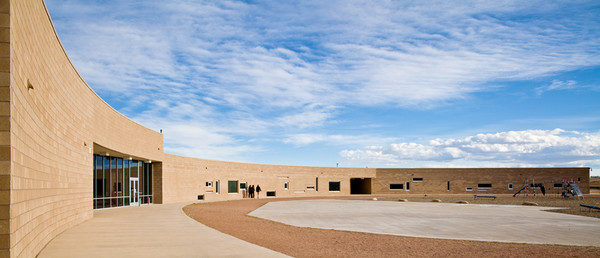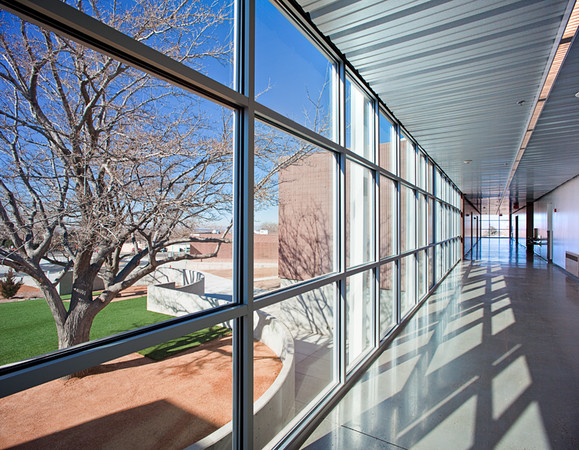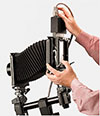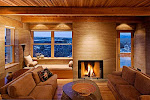Having just spent some time in Chicago photographing medium size sky scrappers with little room to back up, I have come to a conclusion.
DSLRs and tilt/shift lenses are really stretched beyond their limit in big cities and are of marginal quality in situations where tall vertical structures are the norm. Horizontal structures like the Modern Wing shown in the post below photograph fine. But on tall vertical structures you end up using all of your rise, but you still end up having to tilt up and subsequently correct some perspective in
Photoshop with all the interpolation that goes with it. I am not fully happy with the results compared to what I get photographing the lower buildings that you can stand back from in the Southwest. With lower buildings you do not use the outer limits of your lenses where resolution really suffers. My verdict? If I had to make my living working in the Loop in Chicago, I would definitely look at a first rate medium format system such as the
Sinar. Of course if my primary clientele was in the Loop of Chicago, I could afford a first class medium format system.
After thinking about this today, Duh! I think my solution would simply be to revert to using my trusty view camera and scanned color negative film next time-simple cheap and fully capable of doing the job.
From Ed,
I tried posting this to the blog but I did not have the appropriate accounts. I have also struggled with the verticality of the city (I'm based in Boston) and DSLR shift lens limits. I am a stitcher also. There are a few options I've been looking into which you may already have seen that look promising. A company called Zork makes a 35mm dslr shift adapter which adapts the use of medium format lenses (645, 6x6, 6x7) allowing up to 20mm of movement if you go with 6x7 lenes. I'd probably stick with the 645 format due to the availability of a 35mm lens for up to 17mm. Since we are both used to stitching images anyway, having this level of shift could be very useful. It also allows sliding back movements for parallax free stitching which is huge. Photomerge in PS is pretty good but I occasionally get misalignment of tall building mullions if I'm up close with a wide-angle. Medium format resolution, and wide angle of view without the wide angle distortions. The tradeoff is more work at the desktop. Another option I have considered is going to medium format as you suggest but a $50k+ investment in the Sinar or a Hasselblad Shift system is just not going to happen. Zork to the rescue again. They make a MF shift adapter that uses 6x7 lenses (Pentax 67 are pretty good and cheap). The setup I am contemplating is a gently used Contax 645 (~$1,500), The Zork adapter ($1,500 which seems pricey for what it is but what are you going to do?), a range of 5 Pentax 67 lenses (~around $2k for all 5 from KEH.com!) and a factory refurbished Phase One P25 22mp back (which is fine resolution-wise since we are stitching) from Calumet for around $12k. Total cost around $17k. That is still a chunk of change but way less than the Sinar or Hasselblad. I probably have $10k invested in 35mm so not so far off. Maybe you would be so kind as to try out these options for us and report about it on the blog! Also, check out 16-9.net. Here is a link to a roundup of possible shift solutions for anyone used to working in 35mm DSLR:
http://www.stitchpix.com/options.html
Avoiding Parallax:
http://www.outbackphoto.com/workflow/wf_58/essay.html
Other Links:
http://www.zoerk.com/pages/p_psa.htm http://www.contaxcameras.co.uk/645/645.asp http://www.keh.com
from David:
Regarding your recent comments on shooting tall buildings in the city: wouldn't the new Canon 17mm ts-e be of some help here? I know, you'd have to crop somewhat, which reduces quality, but wouldn't that at least be preferable to perspective correction in Photoshop?
Some further thoughts. The issue for me is simple. I have written many times that, coming from 4x5, to get acceptable quality from a DSLR requires very very careful work, minimizing everything that might diminish image quality like , camera movement, cropping, lens distortion, shift limits, diffraction, interpolation etc. In Chicago shooting in the Loop, where my 24 t/s had insufficient rise resulting in stitching vertical frames (that had some necessary converging vertical lines), that too many image deteriorating factors came into play to give me the quality I want. In many cases (street corner buildings) I simply could not get back far enough to avoid these issues. These factors included barrel distortion correction, significant perspective correction and cropping. In one situation I had to shoot from the middle of the street in a crosswalk and actually had to handhold the camera a situation which makes my skin crawl.
Now these images are not being used large, websites or catalogs, and with allot of work I can make them acceptable, but I always try to exceed my clients expectations. I have said before, if you routinely exceed your clients expectations, your clients recommendations will become your best advertising, if you exceed their expectations too much you probably will not be profitable and won't be able to make a living. In the short run to build your initial portfolio this may work, but in the long run you need to control your costs and be economically competitive.
The easiest solution is simply to go back to using my view camera for these shots but I did not anticipate this problem. Using my Schneider 47XL and a center filter (to correct for the lens fall off) on roll film would have worked because of the significantly more rise and less lens distortion I would have had compared to the DSLR with last generation T/S lenses (I would have bought the new 24 before the trip if I could have found one with a US warranty. It at least has less distortion) or use a good 75mm on 4x5. In the comments below another Ed, from New Orleans, suggests a similar and very viable retro option:
For the $1500 the adapter costs, you get a Sinar F2, 90mm and 75mm lenses, and do a better job. Since you are shooting for a client, the film cost should not be an issue.
Kirk, could you elaborate a bit on working in tight city spaces with the view camera? I am doing more shooting in New Orleans, which has some wonderful late 19th century, early 20 century facades, but also has some pretty narrow streets. Should I start saving for a 72mm XL?
Ed from New Orleans,
As you know your solution is perfectly viable and very inexpensive. Film for me can no longer supply my needs for commercial work as we no longer have a lab in this town and doing color myself or shipping it out is just too slow a turn around. BUT for odd necessary shot or my personal work that is no problem. I have coveted but never owned the Schneider 72XL for 4x5. I have owned 75s and 65s but those were of limited coverage on 4x5 and not suitable for extreme rises for tall buildings. If I remember right the 72XL has great coverage (like 226 mm diameter circle of coverage-that is a front rise of 48 mm with the XL vs. 31 mm with the 75 ) and should do the trick. As you are scanning your film you can get by without a center filter which helps alleviate falloff. I have successfully used a white gradient for years to fix falloff. You also need a really solid camera and preferably bag bellows. The extreme movements needed with even a very flexible "universal" bellows can force the front standard to tilt forward with extreme rise. I also prefer for my large format architecture lenses to mount them above center on the lens board to maximize rise. We always seem to need more rise shift than fall (and we can always reverse the lense board and mount it upside down to get more fall). This discussion makes we want to break out one of my 4x5s (I still own two) and go shoot some film! One other thought, though the ability to actually use this solution is rare. Check and see if there is a roof or window across the street from the building you want to shoot that is about half its height. That alleviates the need for such huge coverage lenses and provides an interesting birds eye view from about mid elevation of a tall building. It is also visually appropriate to leave a slight amount of convergence on really tall buildings or they tend to seem like they are falling forward Think also about using really long exposures to significantly blur cars or people. It is virtually impossible to avoid them when the light is right on a building so blur can make them less distracting and provide a juxtaposition to the solidity of the structure.
The solution David suggests about using the new 17 T/S above may have worked but includes significant cropping and may compromise the file to much. It is hard to say without testing that lens. The suggestions of Ed to buy a used Contax 645, Pentax lenses and a Zork adapter......I wonder. Those Pentax lenses don't have that much excess coverage beyond a 6x7 negative size. How much shift are you going to get? I will not be trying any of these options myself soon as my equipment budget for the near future is the new T/S Canons, a new computer for file editing and my oldest daughters upcoming wedding!
From Tonnes:
I suppose if you were in a bind with nothing but your digital camera and didn't have enough rise using your 24 TS-E, you could use a really sharp tele like the 85mm F 1.2 or 1.8 and shoot a vertical panorama of the building. Provided you had enough time to shoot the sequence and you're comfortable using a stitching program like PTgui, the resulting gigapixel image would interpolate very well when you corrected the verticals, no? But ultimately if you try to shoot a tall building from too close, regardless of how the verticals are corrected (optically or in post), things can look weird - namely, the windows get progressively shorter towards the top.
Tonnes,
As you say, in my experience with that kind of complex stitching of buildings
from close up, there is always a fair amount of distortion that cannot be adequately corrected, and the resulting files are just not up to the standards or me or my clients. From a distance this is not an issue and multi-tile stitching is a great way to build quality large file sizes (of potentially unlimited file size for huge prints). Also, for me anyway, AP has become a bit of a volume business and I would rather invest in the proper piece of equipment so I can work quickly rather than laboring over multi-tile stitches and assembling them and correcting them in PS. Billing for all of that would not make any sense to my clients.
More to come.......

















































